
Hypoxis decumbens is a species of plant in the Hypoxidaceae, considered by some authors to be included within the Liliaceae or Amaryllidaceae. The species is widespread across South America, Central America, Mexico, and the West Indies.
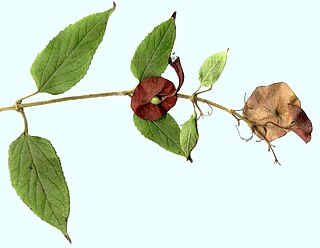
Holmskioldia is a genus of flowering plants in the mint family, Lamiaceae. It is native to the Himalayas but widely cultivated as an ornamental and naturalized in many places It contains only one known species, Holmskioldia sanguinea, commonly called the Chinese hat plant, cup-and-saucer-plant or mandarin's hat.
Triuris hyalina is a species in genus Triuris. It is a tiny flowering plant no more than a few cm tall, lacking chlorophyll and obtaining its nutrients from fungi in the soil. It is known from Brazil, Suriname, Guyana, Colombia, Venezuela.
Thoracocarpus is a genus of plants first described as a genus in 1958. It contains only one known species, Thoracocarpus bissectus a hemiepiphytic vine. It is native to Costa Rica, Panama, Cuba, Trinidad and Tobago, and South America.

Callicarpa acuminata is a species of beautyberry native to Latin America from Mexico to Bolivia. Unlike the other species of this genus, C. acuminata produces small berry-like fruits which can be dark-purple or dark blue-purple. The fruit can sometimes be white. The flowers blooms are white. The fruit grow in tight clumps and sometimes resemble grapes. They are cultivated as garden trees.

Catopsis floribunda is a species in the genus Catopsis. This species is native to the West Indies, Venezuela, Honduras, Oaxaca, and Florida.
Euterpe catinga is a palm species in the genus Euterpe. It is found in forests of a dry, sandy soil and very peculiar vegetation, known as catinga forests or Campinarana in northern South America.
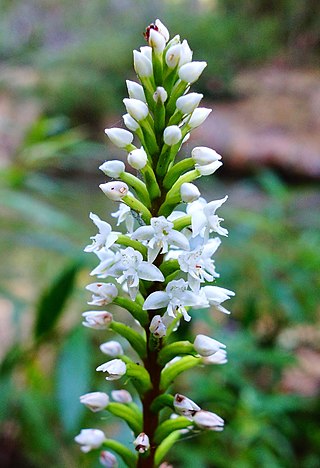
Cranichis muscosa, the cypress-knee helmet orchid, is a species of terrestrial orchid. It is widespread across most of the West Indies, extending into Central America, southern Mexico, Belize, northern South America, and southern Florida.

Cyclopogon elatus is a species of terrestrial orchids. It is widespread across much of Latin America from Mexico and Belize to Argentina, as well as in the West Indies and southern Florida.
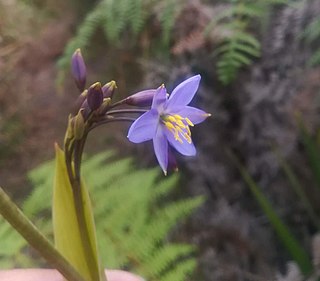
Excremis is a genus of herbs in the family Asphodelaceae, first described as a genus in 1829. There are only one known species, Excremis coarctata, native to South America.
Achlyphila is a genus of plants in the Xyridaceae, first described as a genus in 1960. It contains only one known species, Achlyphila disticha, endemic to the Serranía de la Neblina National Park in the State of Amazonas in southern Venezuela, very close to the border with Brazil.
Aratitiyopea is a monotypic genus of flowering plants, in the family Xyridaceae containing the single species Aratitiyopea lopezii. The genus was erected and described in 1984. This species is native to northern South America.
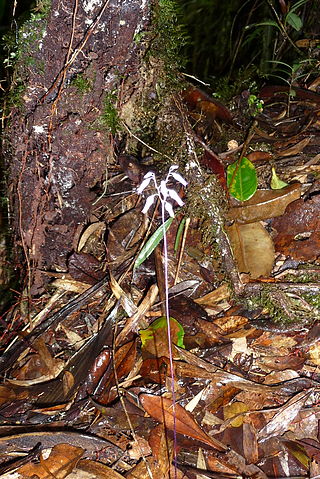
Dictyostega is a genus of flowering plants in the Burmanniaceae, first described as a genus in 1840. It contains only one known species, Dictyostega orobanchoides, native to southern Mexico, Central America, Trinidad, and South America ).

Apteria is a genus of flowering plants in the Burmanniaceae, first described as a genus in 1834. It contains only one known species, Apteria aphylla, the nodding-nixie, native to the southern United States, Mexico, Central America, the West Indies, and South America.
Pyrrorhiza is a genus of herbs in the family Haemodoraceae, first described as a genus in 1957. It contains only one known species, Pyrrorhiza neblinae, endemic to the Sierra de la Neblina in Amazonas State, Venezuela.
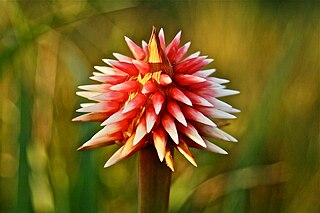
Guacamaya is a group of plants in the family Rapateaceae described as a genus in 1931.
Kunhardtia is a group of plants in the family Rapateaceae described as a genus in 1958.
Phelpsiella is a group of plants in the family Rapateaceae described as a genus in 1958.
Diploon is a genus of plant in the family Sapotaceae described as a genus in 1946.
Egletes viscosa, the erect tropical daisy, is a New World species of flowering plant in the family Asteraceae. It is widespread across much of South America, Central America, Mexico, and the West Indies, just barely crossing the US border into the southernmost county in Texas.









